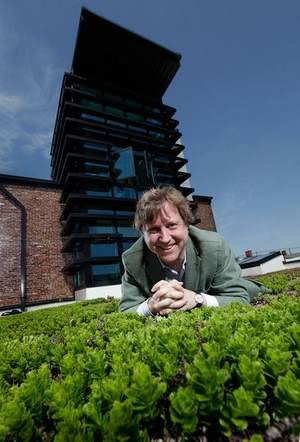Roofs green up: Downtown's overhead
gardens treat the eye and the Earth
Courier-Journal | Matt Frassica
 “I love the rows of mounded blue arctic willow marching in the creeping Jenny,” Brown said later. “It is also quite fun to see the mirrors behind the Japanese maples reflecting the penguins and the Second Street Bridge, a reminder that city living is full of surprises.”
“I love the rows of mounded blue arctic willow marching in the creeping Jenny,” Brown said later. “It is also quite fun to see the mirrors behind the Japanese maples reflecting the penguins and the Second Street Bridge, a reminder that city living is full of surprises.”
But the rooftop garden isn't just about creating a refuge in the middle of the city. It's also a response to environmental pressures. With their acres of paved surfaces absorbing heat, cities are typically hotter than surrounding rural areas — a phenomenon called the heat island effect.
On a building, the roof can get very hot in summer, transmitting that heat to the interior.
Brown hoped that 21c's garden would, in a small way, help reduce the warming effect of all that concrete and tar.
“Rooftop gardens have the ability to reduce the overall heat absorption of the building, which then reduces energy consumption,” she said. “If they are embraced on a larger scale, they can actually help reduce temperatures in the downtown area and lower overall pollution — by sequestering carbon dioxide — and energy consumption.”
Up on the rooftop
For Gill Holland, owner of the Green Building on East Market Street, the green roof was part of his initial idea for a self-sustaining structure.
“It seemed like, it's the 21st century, we should try to make the building as self-sufficient as possible and as carbon offsetting as possible,” Holland said.
The green roof helps both of these ends. The succulent plants that grow on the roof, called sedums, absorb carbon dioxide like all green plants.
The sedums also absorb much of the rain that falls on the building's roof, reducing the runoff flowing into the streets and municipal sewers.
Finally, by reflecting sunlight better than tar paper — and through evaporative cooling caused by the plants' transpiration of water from the roof — they reduce the temperature of the roof in the summer.
“The average tarmac roof goes up to about 180 degrees in summer,” Holland said. “So if you're in a room beneath that, it's like being in an oven — and your air conditioner is down to 72 degrees.”
Although the green roof cost about $20,000 to install, Holland said he expected it to pay for itself through reduced utility bills within six years.
For Holland, the experience of installing the green roof convinced him that every flat-roofed downtown building should do the same.
“I fly into Louisville and I see all the roofs, and I think there should be solar panels and green roofs on all those buildings,” he said. “We would have much cleaner air … if we had more plants on roofs, and we would save tons of money in terms of our carbon footprint and our bottom line.”
Help from the Bernheim
Nana Lampton, chief executive of American Life and Accident Insurance Co. of Kentucky, stood on the roof of her company's building at 471 W. Main St., which was designed by architect Mies van der Rohe.
“Look at all those roofs,” she said, pointing down Main Street toward the handle of the Louisville Slugger Museum's giant bat. Roofs like an undulating tarmac ocean stretched westward as far as the eye could see.
The garden at the American Life building was started in 2009. “I had been reading everywhere about this (roof gardens), and I'm a gardener, so why not?” Lampton recalled. “It was just a natural evolution.”
Lampton enlisted Bernheim Arboretum and Research Forest to help plan her roof garden. Bernheim's gardeners started with sedum, like that found on the Green Building's roof, but also added three small plots with native Kentucky plants from different environments.
One plot, modeled after a rock garden, includes snow in summer and ice plant. Grasses — like purple love grass and blue fescue — grow in the middle plot. The third plot emulates a Kentucky cedar glade, with gray goldenrod and prickly pear.
“We wanted to find things that can withstand the hottest month and the coldest month,” Lampton said. The collaboration with Bernheim worked well because the arboretum was already experimenting with native plants that could survive in roof gardens.
Lampton, too, has seen dramatic decreases in her utility bill since planting the garden in September 2009. “I wanted to do it because I wanted more green, but I didn't know it would save us money,” she said.
The American Life building's roof will soon add a beehive — and Lampton hopes the example of her garden will help spread the idea, like a pollen-laden bee, across the city.
“The goal is to see every roof in this city as a green roof — but there are only a couple,” she said.
Reporter Matt Frassica can be reached at (502) 582-4502.

